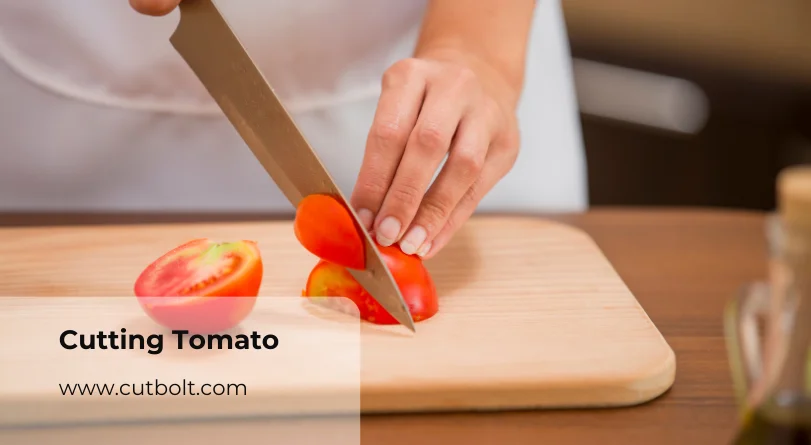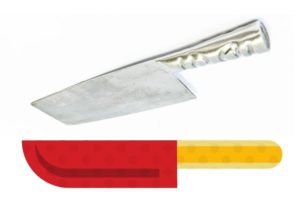As a food enthusiast, I know how important it is to have the right tools in the kitchen. A ripe, juicy tomato is a delicious addition to countless dishes.
However, slicing one can often turn into a mess if you don’t have the right knife. Using an improper knife leads to squashed, uneven slices and tomato juice dripping everywhere. That’s why every home cook needs a quality tomato knife designed specifically for getting picture-perfect slices with ease.
If you want to know how to use a tomato knife, I’ll explain what to look for when selecting a tomato knife, proper cutting techniques, and how to keep your knife in top condition.
With the right tomato knife, you’ll be able to quickly and cleanly slice tomatoes for salads, sandwiches, bruschetta and any recipe that calls for them. Let’s get slicing!

What is a Tomato Knife?
A tomato knife is a serrated knife specially designed for slicing tomatoes and other soft fruits and vegetables. The blade has small scalloped or “saw tooth” edges that efficiently cut through tomato skin without smashing the soft flesh. The curved shape of the knife nicely follows the round contour of tomatoes making even slices a breeze.
Tomato knives typically have blades 4 to 6 inches long made from stainless steel, carbon steel or ceramic.
The most important features are sharp, fine serrations and a blade sturdy enough not to bend when slicing. Look for a knife with a comfortable handle that provides a secure, slip-free grip when your hand is wet. Wood, plastic and rubber are common handle materials.
Why do you need a knife just for tomatoes?
Using a plain knife to slice tomatoes can be frustrating. The skin is slippery and resists being cut cleanly. A smooth blade often results in crushed slices and juice squirting out. In contrast, a tomato knife’s razor-sharp serrated edge effortlessly cuts through the skin without damaging the inside flesh.
Second, using a tomato knife allows you to make clean and precise cuts, which can make your dish look more professional. Finally, using a tomato knife reduces the risk of injury because it is easier to control than a larger knife.
A tomato knife features a blade thin enough to slice tomatoes paper thin if desired yet sturdy enough to create thicker cuts too. The curved shape nicely cradles round tomatoes making uniform slices a cinch. Whether you’re preparing tomatoes for bruschetta, cutting wedges for a salad or layering slices on a sandwich, a tomato knife is the best tool for the job.

How to use a tomato knife?
1. Preparing the tomato for cutting
Before cutting your tomatoes, it’s important to prepare them properly. Start by washing your tomatoes under cold running water and patting them dry with a paper towel. Next, remove any stems or leaves from the top of the tomato.
2. Cutting techniques for different types of recipes
There are several different cutting techniques that you can use when cutting tomatoes:
2.1. Slicing tomatoes
To slice tomatoes, start by cutting off both ends of the tomato so that it stands upright on your cutting board. Then, slice the tomato into thin slices using a back-and-forth sawing motion.
2.2. Dicing tomatoes
To dice tomatoes, start by slicing off both ends of the tomato so that it stands upright on your cutting board. Then, slice the tomato in half from top to bottom. Next, slice each half into thin slices using a back-and-forth sawing motion. Finally, turn the slices 90 degrees and slice them again into small cubes.
3. Wedging tomatoes
To wedge tomatoes, start by slicing off both ends of the tomato so that it stands upright on your cutting board. Then, slice the tomato in half from top to bottom. Next, slice each half into wedges by making diagonal cuts from top to bottom.
Cutting tomatoes for different recipes
How you cut your tomatoes depends on the dish or recipe you are cooking. Here are some examples of tomato cuts depending on the dishes:
- For a Caprese salad: Cut your tomatoes into thick slices and arrange them on a plate with mozzarella and fresh basil. Season with olive oil and balsamic vinegar.
- For a salsa: Cut your tomatoes into small cubes and mix them with onions, jalapeño and cilantro. Season with salt, pepper, lime juice and cumin.
- For a tomato sauce: Cut your tomatoes into small cubes and cook them with garlic, onion and spices. Mix everything to obtain a smooth sauce.
Proper cutting steps with a Tomato Knife
Using proper tomato knife skills ensures cleanly sliced tomatoes every time. Follow these steps for perfect results:
1. Rinse tomatoes and dry
Always rinse tomatoes under cool water to remove any dirt. Gently pat them dry with a paper towel or a clean kitchen towel. This prevents the tomato from slipping while slicing.
2. Place on cutting board or hold in hand
Set the tomato on a cutting board or gently cradle it in your non-dominant hand. Having the tomato poised on a flat surface makes even slices easier.
3. Firmly grip the knife
Hold the knife handle securely, with your dominant hand’s thumb and index finger gripping just below the blade. Keep your knuckles raised off the cutting board for better leverage.
4. Use a gentle sawing motion
Start at the top of the tomato near the stem end. Apply light downward pressure while using a gentle back-and-forth sawing motion to penetrate the skin. Let the serrated edge do the work.
5. Slice from stem to blossom end
Continuing sawing while slowly moving from the stem end to the opposite blossom end. Follow the curved shape of the tomato with your knife for pretty uniform slices.
6. Cut even thickness slices
Make slices as thick or thin as desired, keeping them uniform in thickness. Thin slices work great for bruschetta while thicker slices are nice for sandwiches and burgers.
7. Avoid squashing the slices
Use care not to bend the knife or press too hard, as this can cause the slices to break apart or become crushed. Work slowly and let the serrations slice smoothly.
8. Wipe the blade clean
Before setting the knife down, gently wipe both sides of the blade with a damp towel or cloth to remove tomato juice and seeds. Also, wipe the handle clean to avoid slippery tomato residue.

Choosing the best tomato knife
Not all tomato knives are created equal. Here are the key things to look for when shopping for one:
1. Blade material
Stainless steel is ideal for tomato knife blades. It holds a sharp edge well and resists stains and corrosion. High-carbon steel blades are very sharp but require more care to prevent rusting. Ceramic blades can be super sharp but are more fragile.
2. Serrated edge
Small, sharp teeth are essential for effortlessly cutting through slick tomato skin. Scalloped or Granton edges perform best with their narrow serrations. Avoid blades with large, blunt serrations.
3. Length
Most tomato knives have 4 to 6-inch long blades suitable for slicing all sizes of tomatoes. Compact 3-inch blades work for cherry and grape tomatoes. Larger 8+ inch blades are best for slicing big heirloom varieties.
4. Handle material
Choose a tomato knife with a comfortable, slip-resistant handle. Wood, plastic composite and rubber are common options. Ensure the handle is securely attached to the full tang blade.
How to care for Tomato Knife
With proper care and maintenance, a quality tomato knife will stay sharp and last for years. Here are tips for keeping your knife in optimal shape:
1. Hand washing
Never put a tomato knife or any fine-edged knife in the dishwasher! The harsh detergents and heat can damage the blade. Always hand wash the knife gently with mild dish soap and warm water. Cleaning carbon knives is a bit tricky, here is a guide you can follow.
2. Use a knife guard
Store your tomato knife in a knife guard, sheath or slotted wooden block to protect the fine edge and keep it from becoming dulled or damaged. Never toss knives loose in a drawer.
3. Regular honing
Use a knife steel or ceramic honing rod to realign and straighten the knife’s edge after each use. This keeps the tiny teeth sharp and ready to slice. Honing takes just seconds and extends the time between full sharpenings.
4. Professional sharpening
Have your tomato knife sharpened once a year by a professional sharpener. They’ll grind away any nicks in the edge and reshape the blade for optimal performance.
5. Avoid cutting hard foods
Never use your tomato knife to slice hard foods like winter squash, ice, or bone. Stick to soft fruits and veggies to prevent chips and dents to the thin blade.
Summary: How to use a tomato knife
From selecting the perfect tomato knife to mastering proper slicing techniques, I hope this guide provides all the tips you need for tomato success. A quality tomato knife is a useful addition to any home cook’s kitchen.
Remember to always start by rinsing and drying the tomato so it doesn’t slip while cutting. Hold the knife firmly and use a gentle back-and-forth sawing motion to let the serrated edge glide through the skin. Work slowly from stem to blossom end following the contours of the tomato for pretty, uniform slices. Avoid bending the thin knife blade to prevent crushed slices.
Take care of your tomato knife by hand washing, using a protective sheath, and honing regularly to maintain a sharp edge. Employing proper tomato knife skills takes your tomato-slicing abilities to the next level. Your sandwiches, salads and sides will all be graced with beautiful tomato slices. Grab a tomato and your knife to start slicing!



